 |
|
Miracle Pictographs
|
January 2012
Pictographicus Miraculous In Respectable Circles
Habibi (Pantheon Books, 2011)
I have met my critical match.
I'm staring at Habibi, an enormous, gilded leather-bound tome. It's huge in every
sense. If my son wandered into the room and yanked it off my desk, it might knock
him out. It took days to read, and that was rushing it. Almost seven hundred pages
of thick, detailed illustration, calligraphy and design.
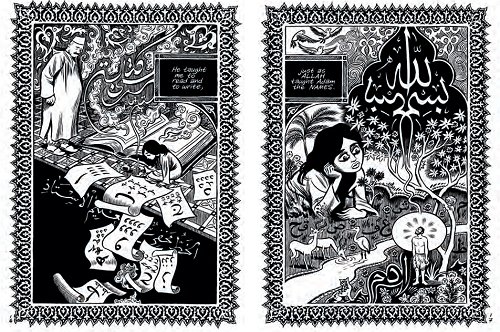
I could spend years poring over Craig Thompson's calligraphy, swooping and
darting to weave myth with the story of two forgotten people.
I could spend years trying to realize what it means to comics, to myself, to love and
God and all the big issues. I could spend years trying to articulate what its flaws
mean, and how they interweave with its strengths in such a way that it is
impossible to separate aspects of the work from each other.
But I have a review to write, and I've got to try and summarize something this big
in just a few days.
God help me.
It's incredible, and I mean that in the original sense of the word. I cannot credit it
as the work of one pen; I cannot comprehend its vastness. It's a work of
calligraphy, of art, of storytelling, and even of architecture. In the realm of
sequential art, it's the first English work to really merge words -- in this case, the
wondrous Arabic alphabet -- with pictures.
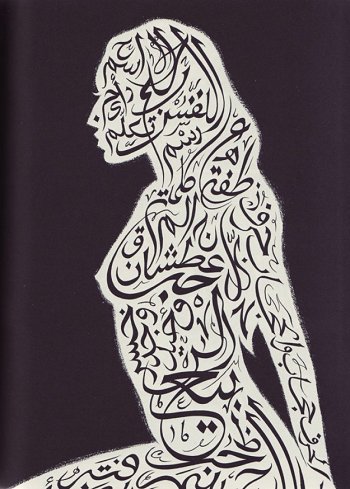
Very few comics even aspire to what Habibi achieves. I would say that four comics
have ever achieved a perfect marriage of text and art. They are Maus, From Hell,
Fun Home and Persepolis.
Maus is probably the greatest comic ever written, a work at once humane and
shocking in its depiction of the Holocaust and one man's perception of why he
survived and how. The simple visual conceit -- Jews as mice and Nazis as cats --
manages to transform the conception of identity. This is a comic about survivors --
about their justifications, their regrets and their ache.
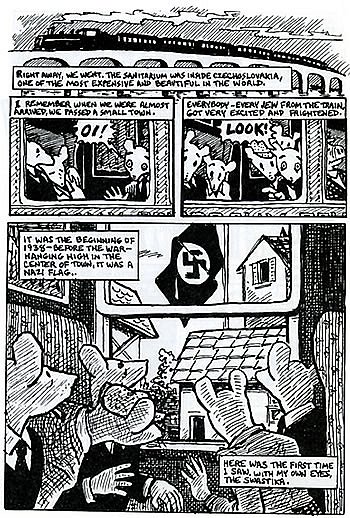
Persepolis is deceptively deep, a tale of growing up in a world at war. The horror
of civil unrest is communicated with the same mundane and quirky art style as the
child's conversations with God and the awkwardness of puberty. It's a work that
shows how precious a simple life is by contrasting it with the transformation of
Iran into a fundamentalist state.
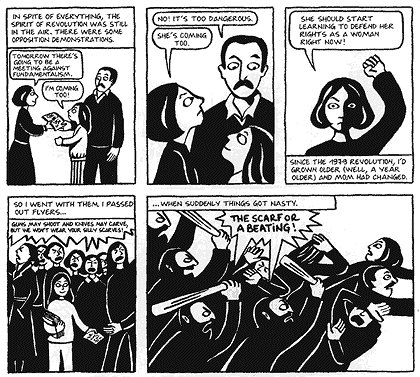
Fun Home is a wrenching chronicle of homosexuality discovered, a narrative in
which a young woman's gay identity mirrors her father's secret life and secret
affairs. Architecture, nature and literature all envelop the piece, contrasting their
structure with the breaking shape of Alison Bechdel's life.
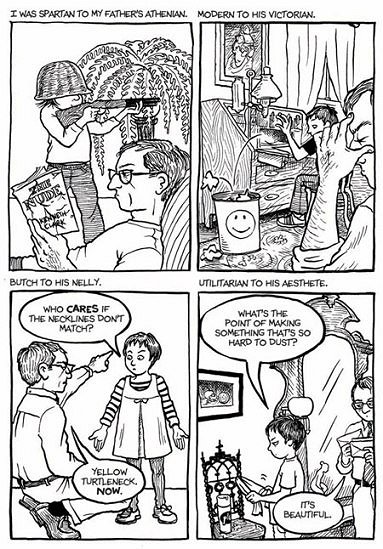
From Hell takes a labyrinthine theory about Jack the Ripper as a royal assassin and
thus turns his murders into a hinge of history and destiny. Watchmen is a minor
work compared to the full-strength Alan Moore of From Hell, playing with the
audience's perception of sanity and fear.
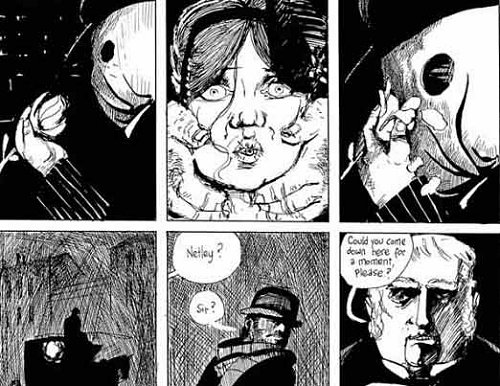
Comics, which marry two art forms, work particularly well for pieces that deal
with the question of identity. The visual and the literary are masks, approximations
of an identity -- the survivors and the marginalized, the terrorized and the broken,
the prophetic and the mad.
So where do we shelve Habibi? Has its ambition and magnificence earned it a
place with these legends of comic art?
It is all the things I've already said -- deep, detailed and sublime. It is about the
identity of the human, the self-creation of the sexual being and the self-creation of
the holy, the debased and the purified. And yet Habibi is deeply, deeply flawed.
While it aspires to the perfect marriage of fictional text and artwork that From Hell
achieved, it is obvious that Craig Thompson's narrative does not have the furious
brain of Alan Moore behind it, and the connections he draws rest on the
believability of his narrative, but the narrative resorts so often to the horrific that it
gets off-balance. What's more, the loaded real-world connotations make it difficult
to read without stopping to wonder why an American is writing this.
Maus, Persepolis and Fun Home are all autobiographical, as was Craig
Thompson's former magnificent work Blankets, which gives their stories an instant
credibility a fiction writer must envy. In that sense, Habibi is really aspiring to
From Hell's niche.
Habibi follows the life of two slaves, Dodola and Zam. Dodola is sold as a child to
a man who "consummates" the marriage with child rape but afterward keeps his
hands off her, teaching her to read and write.
She is then stolen away into slavery. She and Zam find an abandoned boat to live
in out in the desert, and she finds them food through sexual favors, as a child and
then as a woman, for the denizens of nearby caravans.
Zam is her little habibi, "beloved," and Dodola tells him the stories and shows him
the calligraphy that her husband taught her. Their quests for water and food lead
them to split up for one fateful day, when Dodola is stolen away into slavery. Later
Zam is taken in by a strange order of eunuchs, castrated himself, and then offered
up as a candidate for prostitution.
Dodola ends up in a sultan's harem, where her sexual experience makes her his
favorite, and she only gets through her subsequent pregnancy and death of a child
in an opium haze, wishing she were back with her habibi.
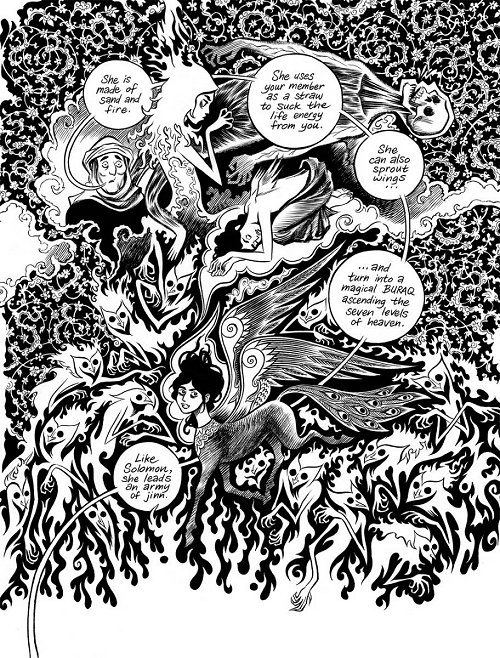
So, in case you haven't gotten it, let me break it down for you: Rape. Child rape.
Qur'anic stories and Islamic myth. Rape. Sex slavery. Rape. Calligraphy. Rape.
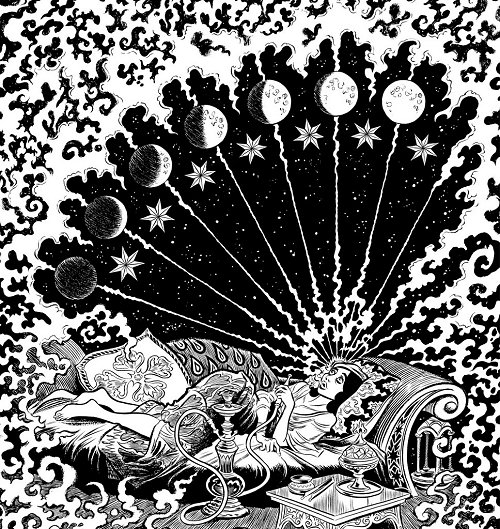
About halfway through, after Dodola was brutalized for the tenth time, I found
myself ironically humming the old song from The Fantasticks. "Oh raaaaaaape . . .
You can get the rape emphatic, you can get the rape polite, you can get the rape
with Indians, a very charming sight . . ." (The song used "rape" in its original
sense of "abduction," and thanks to a linguistic quirk, is now rather off-putting.)
That's Habibi. It's all rape, but you see, the sort of rape depends on what you pay.
For the moment, let's forget about the implications of Craig Thompson, as a white
man, writing a story about an Arabic woman who is repeatedly raped. We'll come
back to it.
Is From Hell horrifying? Oh yes. There is little in graphic art to match the horror of
the scenes where the Ripper, a little old doctor, cuts the prostitutes apart
meticulously. But most of the book is creeping horror. Only a few times in its
enormous narrative does it explode into violence. A little goes a long, long way.
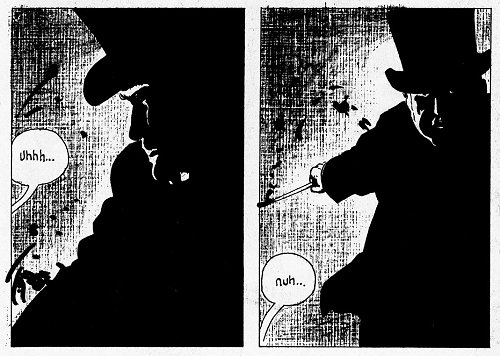
Contrast this with Habibi, which portrays rape after rape in explicit detail. Thud.
Thud. It's as if Jack the Ripper killed fifteen prostitutes, not four, in the six
hundred pages of From Hell.
And yet . . . and yet Habibi is almost there. It's hard for me to say when precisely it
went over the top. Dodola's wedding night is rather well-handled, in which the
horror of child rape is represented only by one stain on the sheet.
Dodola and Zam's stories mirror and reflect holy stories. Their sewer escapes and
their quests for clean water are swept up in calligraphy and countered by the stories
of Noah and the ark and Hagar's search for water in the desert.
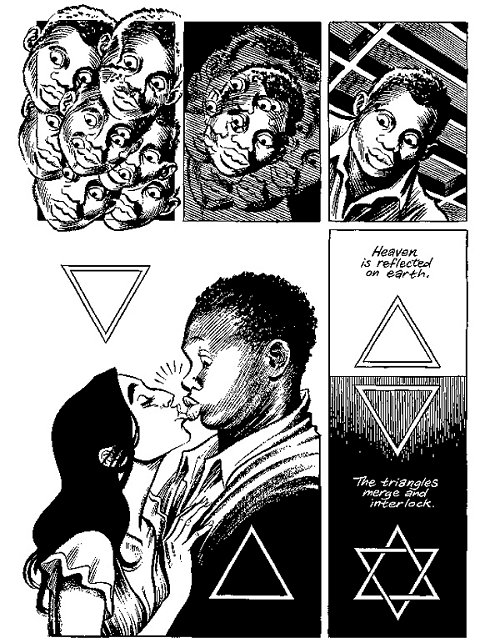
But every work of art also has to deal with the conception the reader will form of
the artist, the God who moves the story. Again, this is easier in frankly
autobiographical works. Reading Habibi, I got a sense that Craig Thompson was
careless with his characters. He was too casually brutal.
It yanks you out of the story -- you start to feel like an accessory to rape. It yanked
me out as a reader. Eventually I found myself asking: why is an American writing
this? Why is our American, white author detailing the rape of this Arab woman?
And what am I perpetuating by reading it?
Storytelling is so intimate. The reader trusts the writer with parental confidence.
When the writer seems careless with cruelty, we almost feel abused. We don't want
the author to be gentle. But we want the cruelty to mean something, to be placed
carefully, to be an explosion of horror, an apotheosis, as in From Hell.
Habibi is not quite there. But that shouldn't stop you from reading it, because it
expresses the potential of comics in a way none of the others do. Few English
artists, perhaps because they are not letterers, truly take the time to consider the
role of text in the art itself. This book marries the artistry of Arabic to story and
picture in wondrous, undreamt-of ways.
I've said before that Alan Moore and Will Eisner were Marlowe and Chaucer, and
the Shakespeares of comics are doing their best work right now. Habibi isn't
Hamlet, nor Othello, but it should be read, for its accomplishments and for future
artists to keep away from its failings.
Continued Below Advertisement
Read more by Spencer Ellsworth